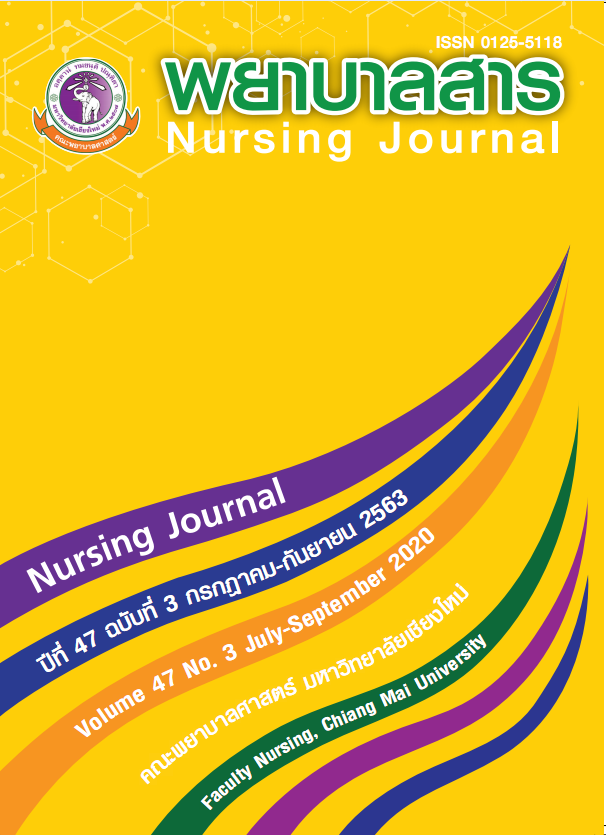Development of Patient Positioning Electronic Book For Nurse Anesthetists
Keywords:
Nurse Anesthetists, Electronic Book, Patient PositioningAbstract
The use of an electronic book (e-book) has provided increased opportunities for nurse anesthetists to improve their knowledge of surgery patient positioning. However, there was no the patient positioning e-book for nurse anesthetists. This study aimed to develop the patient positioning e-book and evaluate nurse anesthetists’ knowledge at Maharaj Nakorn Chiang Mai Hospital after learning from this e-book. Participants were 33 nurse anesthetists who were selected using stratified random sampling based on their experience. Learning outcomes were determined by pre- knowledge assessment test and post-knowledge assessment test that were validated by three experts. The validity index of pre-test score and post-test score were .90 and 1.00, respectively. The reliability index of learning outcome was .91. There were two steps in the data collection process. First, a pilot test was conducted to assess the efficiency of the e-book. Secondly, a field test was performed to evaluate learning via the e-book. The test scores were analyzed by descriptive statistics.
The results of study illustrated that:
- 1. The efficiency index of this patient positioning e-book was 86.11: 96.66, which means that the efficiency of the e-book is satisfactory.
- 2. 33 % of participants had pretest score of less than 80%. After learning using the e-book, all participants improved their knowledge in surgery patient positioning and they received post-test scores of more than 80%. When considering nurses by different working experiences, results showed that before learning with e-book, 11 of 17 high- experienced nurses and 6 of 10 moderate-experienced nurses had pretest score of less than 80%. After learning using the e-book, all three groups of high-experienced nurses, moderate-experienced nurses, and low-experienced nurses had post-test scores of more than 80%.
The study findings revealed the patient positioning e-book has efficiency to increase the knowledge of nurse anesthetists. Therefore, nursing administrators should encourage nurse anesthetists to review contents in this e-book before practicing.
References
USA.
Knowles, M. S., Holton, E. F., & Swanson, R. A. (2005). Adult learner: The definitive classic in
adult education and human resource development (Sixth Edition). Boston: Elsebier.
Malithong, K. (2005). Educational Communication and Technology. Bangkok: Arun Printing.
(In Thai)
Manapattanasatien, T., Chitreecheur, J., & Kasatpibal, N. (2018). Development of an Electronic
Book on Prevention of Multidrug Resistance Organisms Transmission for Registered Nurses.
Nursing Journal, 45(1), 146-158. (In Thai)
Pichai, W., Picheansathian, W., & Yimyam, S. (2017). Development of an Infection Prevention
Electronic Book for Rescue Volunteers. Nursing Journal, 44(1), 113-125. (In Thai)
Pongauksorn, P., Srisa-art, R., & Wongpamornmontree, S. (2018). The Result of Using Electronic
Book to Enhance Suctioning on Achievement of Learning Outcome, Confidence and
Satisfaction of Students. Journal of The Royal Thai Army Nurses, 19(1). 136-145. (In Thai)
Sangkampang, S., Kasatpibal, N., & Viseskul, N. (2018). Development of an HIV Prevention
Electronic Book for Men Who Have Sex with Men. Nursing Journal, 45(3), 11-22. (In Thai)
Songkram, N. (2014). Multimedia for learning: Design and development (3rd edition). Bangkok:
V.Print. (In Thai)
Srifah, P. (2008). E-book Speaking book (2nd edition). Bangkok: Than Books. (In Thai)
Srivilai, W. & Atthamaethakul, W. (2011). Development of an Electronic Book on Anatomy of the
Cardiovascular System and the Lymphatic Vascular System. Journal of Nursing and
education, 4(1), 29-37. (In Thai)
Suttirat, C. (2016). 80 Innovative Learning Management Focuses on Learners (7th edition).
Nonthaburi: P Balance Design and Printing. (In Thai)
Viseskul, N. (2019). Development of Instructional media in nursing Education: teaching Concepts
and Application. Chiang Mai: Chotana Print. (In Thai)
Wannarat, W. (2017). Test Score and Grading. Journal of Humanities and Social Sciences
Rajapruek University, 2(3), 1-11. (In Thai)
Watson, D. S. (2014). Intraoperative Positioning: Risk Reduction Strategies Self -Study
Guide. Retrieved from https://www.medtronic.com/content/dam/covidien/library/
us/en/product/patient-positioning-products/H6861%20Positioning%20Bookletr%
20rev%2011_14.pdf
Wattanawong, S. (2012). Psychology for Adult Training (3rd edition). Bangkok: V. Print. (In Thai)
Yimyam, S., Chareonsanti, C., & Karnasuta, S. (2014). Development of Multimedia Electronic Book
on Basic Knowledge of Breastfeeding for nursing students. Nursing Journal, 41(4), 70-82.
(In Thai)
Downloads
Published
How to Cite
Issue
Section
License
บทความที่ได้รับการตีพิมพ์เป็นลิขสิทธิ์ของวารสารพยาบาลสาร
ข้อความที่ปรากฏในบทความแต่ละเรื่องในวารสารวิชาการเล่มนี้เป็นความคิดเห็นส่วนตัวของผู้เขียนแต่ละท่านไม่เกี่ยวข้องกับมหาวิทยาลัยเชียงใหม่ และคณาจารย์ท่านอื่นๆในมหาวิทยาลัยฯ แต่อย่างใด ความรับผิดชอบองค์ประกอบทั้งหมดของบทความแต่ละเรื่องเป็นของผู้เขียนแต่ละท่าน หากมีความผิดพลาดใด ๆ ผู้เขียนแต่ละท่านจะรับผิดชอบบทความของตนเองแต่ผู้เดียว






